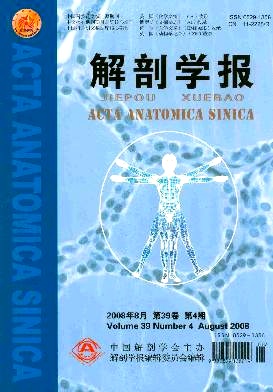|
|
Expression of PCNA, lymphatic vessel density, lymphatic vessel area and their relationship with lymphaticmetastasis in the hamster tongue cancer development
2009, 40 (6):
902-908.
doi: 10.3969/j.issn.0529-1356.2009.06.011
[Abstract] Objective To investigate the relationship of the lymphangiogenesis and lymphatic metastasis by observing the expression of proliferating cell nuclear antigen in the hamster tongue cancer development and analyzing the correlations of lymph vessel density (LVD), lymphatic vessel area (LVA) and malignance or lymphatic metastasis of tongue cancer cells. Methods Forty-two hamster tongue cancer models were induced by painting 1.5% 7,12-dimethylben(a) anthracene (DMBA) acetone solution after scratching, 7 models were sacrificed every two weeks. The pathological changes of tongue cancer were determined by the HE staining. The lymphatic hyperplasia was determined by PCNA and Desmoplakin(DP I +Ⅱ) Immunohistochemical double staining. The tumors and lymphatic endothelial cell proliferation index (proliferation index, PI), lymphatic vessel density (LVD) and lymphatic vessel area (LVA) were measured and statistically analyzed. Results The oncogenesis of tongue was divided into three stages: atypical hyperplasia, carcinoma EM>n situ/EM> and early invasive stage; atypical hyperplasia group:PI (91.55), LVA (7570.23), LVD (2.50); carcinomaEM>in situ/EM> group: PI (113.36), LVA (12105.45), LVD (3.73); early invasive group: PI (124.67), LVA (14524.33), LVD (5.33). The PI, LVA and LVD were compared among groups above (EM>P/EM><0.05), and the correlation of PI with LVA and LVD was positive (EM>P/EM><0.05); Lymphatic metastasis group:PI (130.50), LVA (15430.67), LVD (6.17), non lymphatic metastasis group:PI (113), LVA (12711.67), LVD (3.67), the PI, LVA and LVD were compared between the two groups above (P<0.05).Conclusion With the development of hamster tongue cancer, lymphatic endothelial cell proliferation activity increased, suggesting that the lymphangiogenesis existed in the tongue carcinogenesis process; the values of the LVD and LVA increased in the hamster tongue cancer
Related Articles |
Metrics
|


